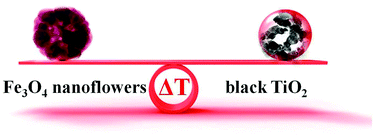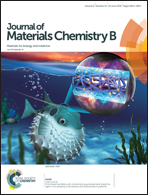Controllable synthesis of Fe3O4 nanoflowers: enhanced imaging guided cancer therapy and comparison of photothermal efficiency with black-TiO2†
Abstract
Photothermal therapy (PTT) has emerged as one of the promising cancer therapy approaches. However, nanoparticles (NPs) which are used for PTT might be biopersistent and potentially toxic. The current research explores the promising use of Fe3O4 nanoflowers as nontoxic, efficient photothermal, and strong T2 type magnetic resonance imaging (MRI) contrast agents for imaging-guided photothermal cancer therapy. In this study, a facile solvothermal method is used to fabricate PEG-coated Fe3O4 nanoflowers with controllable dimensions. Their successful fabrication, the effect of the reaction parameters, and their magnetic properties are investigated in depth. The therapeutic performance of the Fe3O4 nanoflowers (Fe-NFs) is evaluated and compared with commercially available black TiO2 nanoparticles (b-TiO2) under an 808 nm laser. The photothermal therapy efficiency of the Fe-NFs is observed to be better than that of the reported Fe3O4 nanoparticles. In vitro and in vivo investigation demonstrates that the therapeutic performance of the Fe-NFs is comparable to that of b-TiO2. Moreover, the Fe-NFs show excellent magnetic properties and magnetic resonance imaging capability to monitor therapeutic performance.



 Please wait while we load your content...
Please wait while we load your content...